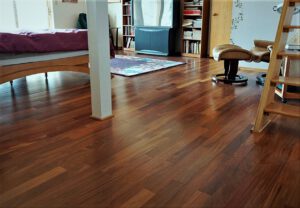Whether you’re building a new home or updating the floors in your existing one, hardwood flooring is a great way to add warmth and elegance.

Hardwood floors are available in a variety of colors and shades to suit almost any interior design theme. They also adapt to changes in decor, so they’ll always look good and fit your lifestyle.
Adding hardwood flooring to your home can increase the value of your property, as well as provide an elegant aesthetic. You may want to install it yourself, but you can also hire a professional.
Typically, the installation cost of hardwood floors varies between $3 and $8 per square foot, depending on the species you choose. In addition, you will need to consider the amount of time it takes for the project to complete. Larger rooms take less time to install than small ones, which will impact your total cost.
The installation process of wood flooring requires precise measurements and careful handling of the material. This is why a professional should be hired to complete the job.
To ensure that the floor is installed correctly, it is recommended to follow the manufacturer’s instructions. This will not only protect your investment but also extend the life of your new floor.
If you decide to do the installation yourself, a few helpful tips can help make the process go more smoothly. Start by laying out the room you’ll be installing in, removing any furniture, and making sure the subfloor is ready for the new floor.
After the area is prepped, it’s time to cut the wood for installation. It is recommended to use a circular saw for this task, as it will provide a more precise cut.
When cutting the wood, it is important to make sure that each piece is at least 6 inches long. This will keep the boards from being too short and causing problems with your installation.
Once the pieces are cut, you’ll need to nail them together. Nail guns are available that will allow you to quickly and easily nail the boards down.
It’s important to follow the manufacturer’s installation instructions, as these can affect the durability of your hardwood flooring. This is especially true if you have to install the floors over concrete or a hard surface.
You should also consider the level of moisture in the environment in which you’re planning to install your hardwood. Taking the proper amount of time for your flooring to acclimate to the humidity can affect how it performs over time, as well as its overall lifespan.
Wood floors can be prone to damage, especially in high-traffic areas. While some damage, like dents and scratches, can be fixed, others, such as rotted wood, termite infestation, or moisture damage, will need to be replaced.
There are many different hardwood flooring repair methods available, so it is important to find the right solution for your unique situation. For example, if you have a small crack in your hardwood floor, repairing it with wood filler and sanding it is often an easy option. However, if you have extensive cracks throughout your floor, it may be more cost-effective to replace the flooring.
Another common type of repair is fixing buckled hardwood flooring. This can be done easily and inexpensively. If your floors are in generally good condition but have a few buckling boards that need replacement, repairing them is a great DIY project to try before calling in the pros for a full-scale refinishing job.
You’ll need a few different tools for this project. First, mark out the area to be repaired with a carpenter’s square. Next, use a wood chisel to split the damaged board into two pieces.
After removing the damaged section, remove any excess wood putty from the area. This will make it easier to re-sand and stain the new hardwood piece.
The sanding and staining process can be long and tedious, but it is worth the effort to get your wood flooring back to looking its best. After the flooring is completely refinished, you will be able to enjoy it for years to come!
Depending on the severity of the damage, you can either fill the holes with a filler, sand them, and then apply a finish. Alternatively, you can sand the entire floor and then apply the same finish.